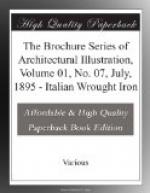It naturally happens that many of the drawings made in the ordinary course of an architect’s work sooner or later fall into the hands of the publishers of some of the architectural papers or are required for publication in other directions. When such drawings have been made without a proper knowledge of the requirements of the reproductive processes the result is frequently very unsatisfactory, and in many cases gives an entirely unfair impression of the design, while this difficulty might have been easily avoided by a little forethought, and without any additional labor.
A few fundamental points which can always be kept in mind will enable draughtsmen to make sure that their work will reproduce well, that is to say, will give a fairly truthful reproduction of the original drawing.
There are at present in use a large number of printing processes depending upon photography as a basis, by which drawings may be duplicated, but they can be roughly divided into two main classes according to the character of the original drawings. In general, line drawings may be treated by one process, while those in which there is a gradation of tones or tints, no matter in what way produced (except by distinct lines), require another and entirely different process. Line reproductions may be made in several different ways, but the requirements in the original drawing are the same in each. The first requisite is that a drawing shall be made in absolutely black ink on white paper, and with clear, firm lines. With a little care it is just as easy to make a drawing in this way as any other, and a satisfactory reproduction can be assured when it is kept in mind that nothing but black will give the best results. In the early days of process work it was customary to use India ink ground by the draughtsman, but excellent liquid inks, such, for instance, as that made by Charles M. Higgins & Co., have taken the place of this, at a great saving of labor and trouble. It is only necessary to take care that the ink is new and not too watery, and that a sufficient amount is carried in the pen to insure a black line. Gray lines, although full and continuous, are very apt to be ragged and broken in the reproduction. Aside from this first condition there are few others which are really mandatory. A drawing made with vigorous, well-defined lines and rather open in treatment will, as a rule, make the most satisfactory reproduction.
There is never difficulty in getting a good reproduction from such work as that by which Mr. H.P. Kirby or Mr. D.A. Gregg is known. For this purpose their style could hardly be improved upon. A drawing can be made with fine and delicate lines and still reproduce well if there is not too much difference in size between the original and the reproduction required. In general, the best results can be obtained by making the plate about two thirds the size of the original.
Drawings in colored inks on tinted paper are difficult to reproduce satisfactorily, and of all combinations a bluish ink upon a yellowish paper is to be avoided.




